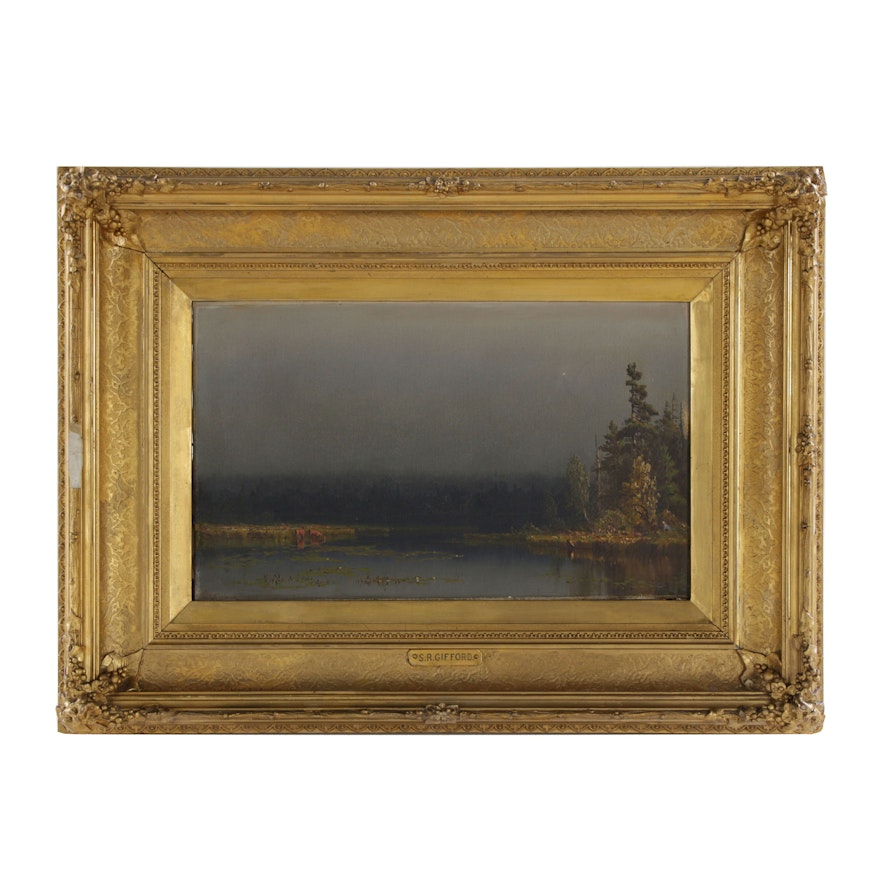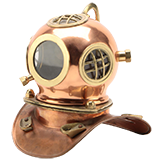Sanford Gifford Oil Painting of Luminist Landscape, 1860
Item Details
Sanford Robinson Gifford (American, 1823 – 1880)
Untitled, 1860
Oil on canvas
Signed and dated “S.R. Gifford 1860” to lower left
Inscriptions to stretcher and frame verso provide dimensions
Metal name plate affixed to lower center of frame
Provenance
From the estate of June Hallett Richdale Smoot, descended from Samuel Hallet (1827 – 1864), who may have purchased the painting from the artist in 1861.
Everything But the House is grateful to Dr. Ila Weiss who examined and provided a letter of authentication for this work.
An oil painting on canvas of a luminist landscape by renowned Hudson River School artist Sanford Robinson Gifford (American, 1823 – 1880), created in 1860. This work features a nocturnal lake scene with diminutive cows standing along the left bank, reflected on the water. Waterlilies are interspersed throughout the foreground and a diminutive figure is visible to the far right, surrounded by the undergrowth of wooded bank with pine trees. The painting is signed and dated ‘S.R. Gifford. 1860.’ to the lower left and is presented gilt gesso wood frame with foliate and berry molding.
Hudson River School artists of the 19th century often painted two types of landscapes: the “sublime’ landscape and ‘luminist’ landscape. As opposed to the sublime landscape, which tends to focus on the unpredictable, even dangerous aspects of nature, the “luminist landscape”, as exemplified in this work by Gifford, tends to focus on the subtle infusion of light, much more subtle tonal gradations in the sky, a more tranquil scene with placid waters, and an emphasis placed on the horizontal expanse. This particular work also features a forested area with hazy, obscured details throughout the horizon, that illustrate a sense of distance and atmospheric fog, an aspect that was often rendered in Gifford’s luminist paintings.
This nocturnal landscape may picture Kauterskill Lake located in New York’s Catskill Mountains, a subject repeatedly painted by Gifford, however this is not confirmed. Gifford regularly painted lake scenes of the Hudson River Valley and the New England area, and particularly scenes of Kauterskill Lake and Kauterskill Falls several times. It was not unusual for Gifford and other Hudson River School artists to paint the same subject repeatedly, either from different perspectives, or as studies for larger or more complex paintings.
According to Sanford Gifford scholar Dr. Ila Weiss, this painting is an outlier among the artist’s ouvre, given its somber tonality and lack of a light source. It was painted at a time that Gifford was maturing as an artist and gaining more popularity among his contemporaries. Interestingly, it was also completed one year before the artist enlisted in the army for the American Civil War. At this time, Gifford was experimenting with dark and night effects, leading up to some of his more unusual work that he painted during the Civil War, which exhibited more dramatic, infernal qualities, such as overwhelming sunlight, and dilapidated or barren trees, perhaps as a reflection of the tumultuous times caused by the War.
This painting is from the collection of June Hallett Richdale Smoot, the great-great granddaughter of Samuel Hallett (1827 – 1864). Hallett was an affluent gentleman and a pioneer in the development of the American railroads in the 19th century. He was especially known for his development of the eastern branch of the Union Pacific Railroad and the bank Hallett & Co. Bank that he opened in New York City. In 1854 Hallett built a stately home known as the ‘Hallett House’ or ‘The Aisle of Pines’, located in Wayne, New York. While the home was lost due to a devastating fire in the 1970s, both of the Sanford Gifford paintings in this Landmark sale were fortunately saved.
Sanford Robinson Gifford was a leading second-generation Hudson River School artist who was celebrated for his mastery of light and atmosphere. He is the only known Hudson River School artist to have been born and raised in the Hudson River Valley. He may have received early art instruction from Henry Ary, who was previously a neighbor of Thomas Cole, the father of the Hudson River School. Gifford studied at Brown University for two years but left before graduating in pursuit of becoming an artist. He moved to New York City where he studied with the English emigré John Rubens Smith, who trained him as a portrait and figural painter; however, Gifford soon thereafter pursued landscape painting. He exhibited his first painting in 1847 at the National Academy of Design, then submitted almost annually to the Academy. Gifford was elected an associate of the Academy in 1850, and a full Academician in 1854. His artistic maturity began to develop in the mid 1850s while traveling and studying in Europe. It was in Europe that he studied a copied J.M.W. Turner’s work in London’s National Gallery. He continued to travel extensively throughout Europe, then settled in Rome in 1856, where he painted his first major work Lake Nemi (Toledo Museum of Art), which was well-received at the Academy, and featured his signature radiant sunlight and filmy atmosphere for which he is most well-known. In the fall of 1857, Gifford moved back to New York City and rented a studio in the new Studio Building, where Frederic Church, Albert Bierstadt, and other landscape painters also rented. Although Gifford was known for his luminist style, it was in the 1860s that his work began to show a shift, exhibiting some sublime qualities, which may have been influenced by the fact that the artist was serving in the Civil War and lost his brother Edward in the War and his brother Charles who committed suicide. In 1867, one of his paintings, in addition to a painting by Winslow Homer, was chosen to represent American art at the Exposition Universelle in Paris. Like other Hudson River School artists, Gifford traveled and painted landscapes abroad in several countries including Egypt, Turkey, Greece, in addition to several countries throughout Europe. In 1880, the artist contracted a respiratory ailment while on a fishing excursion, which caused his untimely death at the age of fifty-six. A year after his death, the Metropolitan Museum of Art accorded Gifford their first monographic retrospective in their new building located in Central Park. His work has been exhibited and collected extensively by numerous institutions including the Smithsonian American Art Museum, the National Gallery of Art, the Wadsworth Atheneum, the Corcoran Gallery of Art, and the Philadelphia Museum of Art, among many others.
Condition
- rubbing and paint loss throughout edges of painting; evidence of inpainting along right and left edges and across the signature; toning present throughout painting; gold-tone paint remnants marked along edges of painting, especially visible to mid-right edge and upper left edge; small spots of accretion scattered throughout; wear to frame include two-inch chip along left edge, small cracks, and finish loss scattered throughout.
Dimensions
- measurement of frame; canvas size measures approximately 14.75" W x 9" H.
Item #
ITMG463417
Additional Information
Watch Senior Art & Merchandising Specialist, Kara Swami, discuss the provenance of this piece.








































